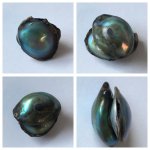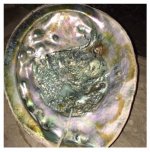It appears to have formed into two different shaped pearls that are stuck together. One jeweler suggested it be offered to someone as a collectible due to its shape.
Hi davcz, welcome to P-G.
Your pearl is interesting. Red Abalone (Haliotis rufescens) is the largest of the abalone family and ranges from Baja to British Columbia.
This type of pearl is what's known as a perforation. It's the most common type of pearl we'll see from gastropods of this genus. Abalone have very thin mantle skirts which are normally quite flexible because these animals are highly mobile. However during these stretches, abalone are quite vulnerable whether by straining or attacked by predators. If a small tear in the mantle occurs, they'll usually heal normally, but if the perforation is large enough, a pearl will form to fill the space. After all, the mantle builds the shell.
This one is interesting because it appears to be a double pearl. meaning that it once dislodged itself from the mantle. The fourth image shows this very clearly. You'll notice the right side has a brown edge surrounding it. This is the active attachment to the mantle. The left side of the pearl popped out, turning a few degrees, re-lodging itself in the extrapallial space. As the right side formed, the left side continued to be mineralized which is why it's bigger and has no visible periostracial ridge. (It's buried in subsequent growth)
Abalone pearls a nice in that they are easily identified as such. Unlike most pearls which can be difficult to identify. They have rich colors, luster and density and often tremendous size.
The classic horn shapes from hepatopancreatis are sought most often. Round, baroque or free form shapes from the gonadal or adductoral linings are also sought. Unfortunately, perforations are the least desirable from this species unless they have an appealing shape to a crafter. Pearls of this type are more suited to folk art pieces or collectibles as curiosities.
At P-G we're wary to appraise value because in pieces like these, beauty is in the eye of the beholder. More often than not, we'll suggest the finder retain the item as a keepsake and enjoy it for the experience. Abalone diving in California is a great opportunity.
You have a terrific pearl and a rare find. Thank you for sharing it with us.




